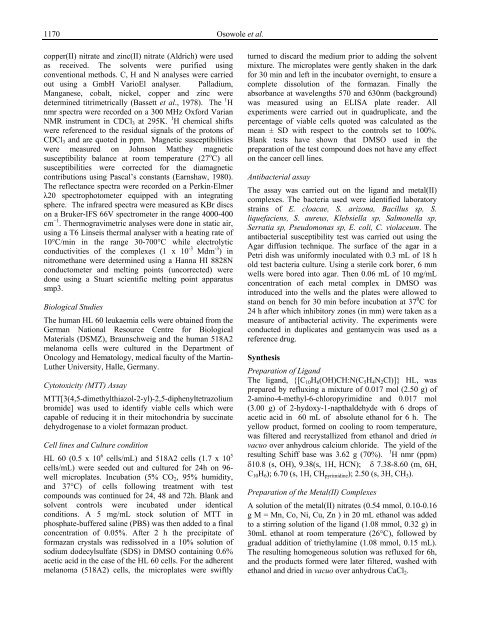Download (5Mb) - Covenant University Repository
Download (5Mb) - Covenant University Repository
Download (5Mb) - Covenant University Repository
Create successful ePaper yourself
Turn your PDF publications into a flip-book with our unique Google optimized e-Paper software.
1170<br />
copper(II) nitrate and zinc(II) nitrate (Aldrich) were used<br />
as received. The solvents were purified using<br />
conventional methods. C, H and N analyses were carried<br />
out using a GmbH VarioEl analyser. Palladium,<br />
Manganese, cobalt, nickel, copper and zinc were<br />
determined titrimetrically (Bassett et al., 1978). The 1 H<br />
nmr spectra were recorded on a 300 MHz Oxford Varian<br />
NMR instrument in CDCl3 at 295K. 1 H chemical shifts<br />
were referenced to the residual signals of the protons of<br />
CDCl3 and are quoted in ppm. Magnetic susceptibilities<br />
were measured on Johnson Matthey magnetic<br />
susceptibility balance at room temperature (27 o C) all<br />
susceptibilities were corrected for the diamagnetic<br />
contributions using Pascal’s constants (Earnshaw, 1980).<br />
The reflectance spectra were recorded on a Perkin-Elmer<br />
λ20 spectrophotometer equipped with an integrating<br />
sphere. The infrared spectra were measured as KBr discs<br />
on a Bruker-IFS 66V spectrometer in the range 4000-400<br />
cm −1 . Thermogravimetric analyses were done in static air,<br />
using a T6 Linseis thermal analyser with a heating rate of<br />
10°C/min in the range 30-700°C while electrolytic<br />
conductivities of the complexes (1 x 10 -3 Mdm -3 ) in<br />
nitromethane were determined using a Hanna HI 8828N<br />
conductometer and melting points (uncorrected) were<br />
done using a Stuart scientific melting point apparatus<br />
smp3.<br />
Biological Studies<br />
The human HL 60 leukaemia cells were obtained from the<br />
German National Resource Centre for Biological<br />
Materials (DSMZ), Braunschweig and the human 518A2<br />
melanoma cells were cultured in the Department of<br />
Oncology and Hematology, medical faculty of the Martin-<br />
Luther <strong>University</strong>, Halle, Germany.<br />
Cytotoxicity (MTT) Assay<br />
MTT[3(4,5-dimethylthiazol-2-yl)-2,5-diphenyltetrazolium<br />
bromide] was used to identify viable cells which were<br />
capable of reducing it in their mitochondria by succinate<br />
dehydrogenase to a violet formazan product.<br />
Cell lines and Culture condition<br />
HL 60 (0.5 x 10 6 cells/mL) and 518A2 cells (1.7 x 10 5<br />
cells/mL) were seeded out and cultured for 24h on 96well<br />
microplates. Incubation (5% CO2, 95% humidity,<br />
and 37°C) of cells following treatment with test<br />
compounds was continued for 24, 48 and 72h. Blank and<br />
solvent controls were incubated under identical<br />
conditions. A 5 mg/mL stock solution of MTT in<br />
phosphate-buffered saline (PBS) was then added to a final<br />
concentration of 0.05%. After 2 h the precipitate of<br />
formazan crystals was redissolved in a 10% solution of<br />
sodium dodecylsulfate (SDS) in DMSO containing 0.6%<br />
acetic acid in the case of the HL 60 cells. For the adherent<br />
melanoma (518A2) cells, the microplates were swiftly<br />
Osowole et al.<br />
turned to discard the medium prior to adding the solvent<br />
mixture. The microplates were gently shaken in the dark<br />
for 30 min and left in the incubator overnight, to ensure a<br />
complete dissolution of the formazan. Finally the<br />
absorbance at wavelengths 570 and 630nm (background)<br />
was measured using an ELISA plate reader. All<br />
experiments were carried out in quadruplicate, and the<br />
percentage of viable cells quoted was calculated as the<br />
mean ± SD with respect to the controls set to 100%.<br />
Blank tests have shown that DMSO used in the<br />
preparation of the test compound does not have any effect<br />
on the cancer cell lines.<br />
Antibacterial assay<br />
The assay was carried out on the ligand and metal(II)<br />
complexes. The bacteria used were identified laboratory<br />
strains of E. cloacae, S. arizona, Bacillus sp, S.<br />
liquefaciens, S. aureus, Klebsiella sp, Salmonella sp,<br />
Serratia sp, Pseudomonas sp, E. coli, C. violaceum. The<br />
antibacterial susceptibility test was carried out using the<br />
Agar diffusion technique. The surface of the agar in a<br />
Petri dish was uniformly inoculated with 0.3 mL of 18 h<br />
old test bacteria culture. Using a sterile cork borer, 6 mm<br />
wells were bored into agar. Then 0.06 mL of 10 mg/mL<br />
concentration of each metal complex in DMSO was<br />
introduced into the wells and the plates were allowed to<br />
stand on bench for 30 min before incubation at 37 0 C for<br />
24 h after which inhibitory zones (in mm) were taken as a<br />
measure of antibacterial activity. The experiments were<br />
conducted in duplicates and gentamycin was used as a<br />
reference drug.<br />
Synthesis<br />
Preparation of Ligand<br />
The ligand, {[C10H6(OH)CH:N(C5H4N2Cl)]} HL, was<br />
prepared by refluxing a mixture of 0.017 mol (2.50 g) of<br />
2-amino-4-methyl-6-chloropyrimidine and 0.017 mol<br />
(3.00 g) of 2-hydoxy-1-napthaldehyde with 6 drops of<br />
acetic acid in 60 mL of absolute ethanol for 6 h. The<br />
yellow product, formed on cooling to room temperature,<br />
was filtered and recrystallized from ethanol and dried in<br />
vacuo over anhydrous calcium chloride. The yield of the<br />
resulting Schiff base was 3.62 g (70%). 1 H nmr (ppm)<br />
δ10.8 (s, OH), 9.38(s, 1H, HCN); δ 7.38-8.60 (m, 6H,<br />
C10H6); 6.70 (s, 1H, CHpyrimidine); 2.50 (s, 3H, CH3).<br />
Preparation of the Metal(II) Complexes<br />
A solution of the metal(II) nitrates (0.54 mmol, 0.10-0.16<br />
g M = Mn, Co, Ni, Cu, Zn ) in 20 mL ethanol was added<br />
to a stirring solution of the ligand (1.08 mmol, 0.32 g) in<br />
30mL ethanol at room temperature (26°C), followed by<br />
gradual addition of triethylamine (1.08 mmol, 0.15 mL).<br />
The resulting homogeneous solution was refluxed for 6h,<br />
and the products formed were later filtered, washed with<br />
ethanol and dried in vacuo over anhydrous CaCl2.

















